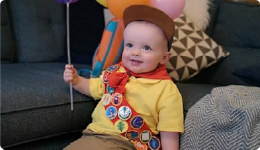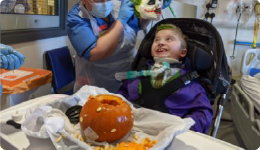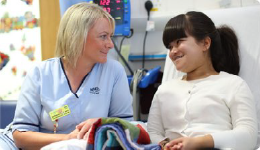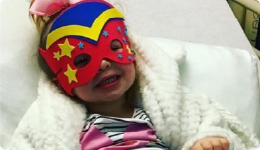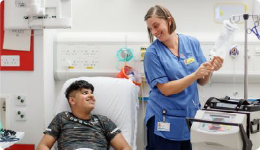Your child should be able to take off their clothes by themselves. They might need help with fastenings.
They should be able to put on loose fitting clothes like pyjamas or shorts and t-shirt by themselves. They can unzip their jacket and might be able to manage large buttons if they can see them.
At nursery there are usually adults around to help children with dressing tasks. Make dressing as easy as possible by thinking about what your child is wearing.
Planning your Child's Nursery Wardrobe
Thinking about the clothes your child wears to nursery can make it easier for your child and the nursery staff. Below are some things to think about:
 Shoes/Boots
Shoes/Boots
- Slip on, Velcro or zip fastenings
- Find out more about Choosing Footwear for Children on the Association of Paediatric Chartered Physiotherapists website.
- Trousers/Bottoms
- Elastic waist bands
- Loose fitting
- Avoid tights, try leggings and socks instead.
- Jacket/Coat
- Loose fitting
- Large sturdy zip; add a zip pull to make the tab easier to grasp and pull up
- Velcro or snap fastenings.
- Hats
- Loose fitting or stretchy
- Scarf
- Try a neck tube
- Gloves
- Try mittens that go over the coat sleeve
- Bag
- Rucksack or crossbody bag, big enough to hold change of clothes, water bottle and a book
- Zip closure, add a zip pull to make grasping and opening/closing easier
- Find out more about Choosing the Right School Bag on the Association of Paediatric Chartered Physiotherapists website.
Putting On and Taking Off a Jacket
By 2 years your child might be able to take off their unfastened jacket. Between the ages of 3 and 4, your child will be learning to put their jacket on themselves. They probably won't be able to do the zips or buttons themselves for a little bit longer.
Here are some tips to help you to teach your child to take off and put on their jacket:
- Practice taking off their jacket first – it’s easier!
- Start with a jacket that is a bit too big. Loose-fitting clothing is easier to manage than tight-fitting clothing. Let them practice putting on your jacket. Make it into a game.
- Your child needs lots of practice putting their arms into sleeves. So practice with shirts, cardigans, pyjama tops, etc.
- If your child is struggling it can be tempting to take over - don't! Give your child time to work it out for themselves. Give them lots of encouragement and hints if you need to. If needed, talk them through what to do and only step in if they get really stuck.
- Make sure you have got plenty of time to practice.
- Instead of correcting a mistake (like a twisted collar or hood) why not encourage your child to look in the mirror. Now get them to work out what's wrong. You may need to ask them some questions and give them some hints.
- There are different ways you can put on your jacket. Try them all to see which way works for your child. Once you have found the way that suits your child share this with other people. Make sure nursery/school staff, grandparents, child minder etc. all help the same way. Try these to find out what one works for your child:
Socks and Shoes
Babies love to take their socks off. They can usually manage this by themselves by the time they are 15 months old. Learning to put socks on is much harder.
Children learn to take their shoes off first. They can usually pull on wellies, slippers and slip-on shoes by the time they are 2 years old.
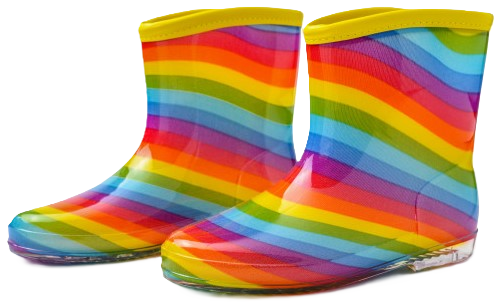
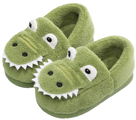
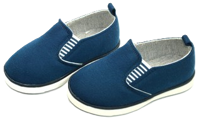
Socks
- Practice using loose fitting socks that are too big, they could even practice putting on your socks.
- Avoid socks which have overly tight elastic at ankles.
- Socks with different coloured toes and/or heels can make it easier for your child to get their socks the right way round.
- Encourage your child to sit when putting their socks on their feet, as they will be less likely to lose their balance.
- It is often helpful for you to sit next to or behind your child when they are completing this task as it will give you a more realistic view of what things they are finding difficult.
- You can start by putting the socks over your child’s toes and heels and getting them to pull the socks up. Once they can do this just put the socks over their toes and they need to pull them up over their heel and all the way up.
- Encourage your child to place their thumbs inside the sock to help them pulling the socks up or on.
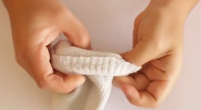 Teach your child to gather up the sock from the top to the heel using two hands, before placing the socks on their toes.
Teach your child to gather up the sock from the top to the heel using two hands, before placing the socks on their toes.- Some children don't like the feeling of wearing socks and can be particularly bothered by seams, you could try turning your child's socks inside out or buy seamless socks.
Here is a video from our OT colleagues in NHS Forth Valley for helping children put on their socks.
Shoes
- Practice with slip on shoes, slippers and wellies first.
- If your child has to change shoes in nursery try to avoid laces or buckles if you want them to be able to do it for themselves.
- It helps if you sit next to or behind your child when they are putting their shoes on as it will give you a better view of what they are finding difficult.
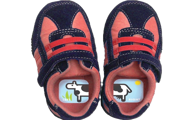 Put the shoes in front of your child the right way round and try the sticker trick (cut a sticker in half and stick one half in each shoe) to help them work out which shoe goes on which foot.
Put the shoes in front of your child the right way round and try the sticker trick (cut a sticker in half and stick one half in each shoe) to help them work out which shoe goes on which foot.- Encourage your child to sit when putting their shoes on, as they will be less likely to lose their balance.
- Get your child to look at their feet to check the shoes are on the right feet.
- Once they have mastered slip on shoes move on to simple fastenings such as Velcro or zips.



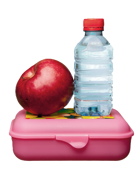 make sure it is big enough to hold lunch, snacks and a plastic drinks bottle with extra room to make it easy to put everything away when your child is finished
make sure it is big enough to hold lunch, snacks and a plastic drinks bottle with extra room to make it easy to put everything away when your child is finished

 You place the toilet paper in your child’s hand. Then you guide their hand to their bottom and wipe together. Some children do not like having their hand touched in this way. Only choose this method if it works for you and your child.
You place the toilet paper in your child’s hand. Then you guide their hand to their bottom and wipe together. Some children do not like having their hand touched in this way. Only choose this method if it works for you and your child. 
